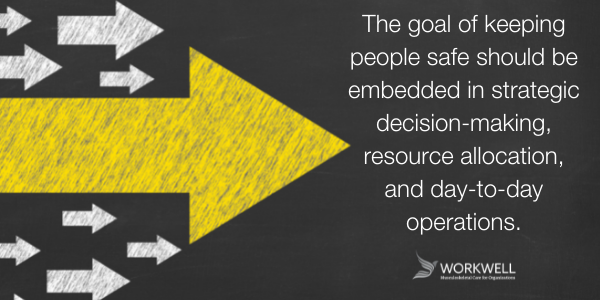Prevent It


Why Aligning Risk Management is Vital for Both Employee and Organizational Wellbeing
Today’s organizations need to worry about a variety of risks, including regulatory noncompliance, cybersecurity, environmental hazards, and labor shortages. Any one of these unaddressed threats can damage their profitability and/or reputation, causing lost business and market share. To be resilient, organizations need to incorporate risk management into their decision-making and resource allocation throughout their operations.
Enterprise risk management (ERM) frameworks have evolved to help organizations identify and manage risks in an integrated way. The portfolio of risk factors encompasses supply chain, operational, financial, and reputational risks. Responses include treating threats across areas such as quality, environmental management, and health and safety. By assessing and proactively responding to these various threats, organizations can help ensure business continuity and long-term viability.
EHS Programs Reduce Risk and Enhance Business Resiliency
Regarding health and safety, people and process safety are major operational risk factors. Many enterprises now understand that managing and improving employee safety and wellbeing contributes positively to their profitability. For instance, one study shows that supporting environment, health, and safety (EHS) initiatives enables enterprises to better meet their business objectives and adapt to change.
EHS professionals are on the frontline for employee safety initiatives, playing a critical role in helping organizations improve worker health and maintain regulatory compliance. EHS programs help organizations improve efficiencies, comply with regulations, and safeguard people from environmental impacts. By identifying workplace hazards and implementing well-designed safety protocols, EHS managers can reduce injury incidents, enhance worker productivity, and strengthen employee loyalty.
Aligning Risk Management across Organizational Silos
But risk management activities, combined with senior leadership’s commitment to employee wellbeing, must be embraced across the enterprise.
The goal of keeping people safe should be embedded in its strategic decision-making, resource allocation, and day-to-day operations.
A recent LNS Research survey cites a lack of collaboration between departments as a key problem with addressing EHS issues. For example, post pandemic, we are seeing a disconnect between EHS and talent recruitment. Recruitment is scrambling to find and hire the right people due to the labor shortage and wants to remove any friction during the hiring process, including POET testing. POET helps firms make informed hiring decisions based on evidence-based, compliant information from trained medical professionals. When companies skip POET testing, they run the risk of the new employee not able to meet the physical demands of the job, which costs the company more long term. POET only delays the hiring process for a few days and can decrease work-related injuries, decrease Workers’ Comp costs, and increase productivity by hiring the person.
The idea is for departments to work collaboratively across silos to identify and resolve a particular threat. In the example above, the threat is hiring someone that can’t physically perform the job. Another example that we see is a manufacturer may discover that their ambitious productivity quotas substantially increase the risk of musculoskeletal injuries, which are contributing to unacceptably high worker absenteeism rates and turnover. In response, the organization could request HR to hire more personnel or provide additional training for new hires. Or the EHS manager could recommend ways to update production processes to improve safety and reduce injuries. The solution would be developed and implemented by the various managers involved, with a specific EHS goal in mind.
Select a topic
- View all topics
- WorkWell
- Safety Culture
- Onsite PT Clinics
- Ergonomics
- Injury/Illness Prevention
- Employee Wellness
- MSK
- Industry News
- POET
- Safety
- Managed Services
- Manufacturing
- Functional Job Descriptions
- Onsite PT
- FJD
- Post Offer Employment Training
- Provider Network
- Blog
- Events
- Featured
- OSHA
- Work Readiness
- Company News
- Job Coaching
- MSK Strategy
- Musculoskeletal
- PT Solutions Employee
- Presenteeism
- Push/Pull
- Recruitment
- Training
- Trust
- Worksite Rounds
Subscribe to Our Blog
Practical tips focused on workplace injury prevention.
Featured Posts
postsTags [BlogPost 178613021575 Shift to Prevention and End the Game of Whack-a-Mole, BlogPost 125116526205 Why now is the time for a Managed Onsite MSK Clinic]
.png)

